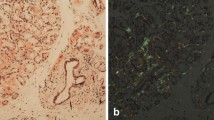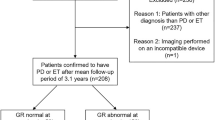Abstract
To investigate the predictive value of minor salivary gland biopsy in clinically diagnosed early stage Parkinson’s disease (PD) patients, and to provide more evidence of minor salivary gland biopsy as a pathological diagnostic biomarker of PD. Thirteen patients with early stage PD and 13 age-matched controls were recruited. Hoehn and Yahr stage and Unified Parkinson’s disease Rating Scale Part III were employed to evaluate their severity of the disease. All the subjects underwent minor salivary gland biopsy and 11C-methyl-N-2β-carbomethoxy-3β-(4-fluorophenyl) tropane (11C-CFT) DAT-PET scan. Immunohistochemical staining for Lewy-type alpha-synucleinopathy using antibody against alpha-synuclein (α-Syn) was performed in the tissues obtained from minor salivary gland. Abnormal accumulation of α-Syn was found around the gland cells in 9 of the 13 patients with PD, but in none of the control subjects. The α-Syn immunoreactive structures were located in the periacinar space. Twelve clinically diagnosed PD patients showed asymmetrical and relatively severe reduction of 11C-CFT uptake in the posterior putamen compared with the control. The sensitivity, specificity, positive predictive value and negative predictive value of minor salivary gland biopsy were 75, 100, 100 and 25%, respectively, when compared with the DAT-PET imaging. Our results suggest that minor salivary gland biopsy does not hold high diagnostic accuracy as DAT-PET, but still has the potential to be a useful pathologic biomarker for PD, which is worth more investigations.

Similar content being viewed by others
References
Hughes AJ et al (1992) Accuracy of clinical diagnosis of idiopathic Parkinson’s disease: a clinico-pathological study of 100 cases. J Neurol Neurosurg Psychiatry 55(3):181–184
Poewe W (2008) Non-motor symptoms in Parkinson’s disease. Eur J Neurol 15(Suppl 1):14–20
Yasuda T et al (2013) Neurodegenerative changes initiated by presynaptic dysfunction. Transl Neurodegener 2(1):16
Dickson DW et al (2009) Neuropathological assessment of Parkinson’s disease: refining the diagnostic criteria. Lancet Neurol 8(12):1150–1157
Lebouvier T et al (2010) Biopsable neural tissues: toward new biomarkers for Parkinson’s disease? Front Psychiatry 1:128
Michell AW, Luheshi LM, Barker RA (2005) Skin and platelet alpha-synuclein as peripheral biomarkers of Parkinson’s disease. Neurosci Lett 381(3):294–298
Miki Y et al (2010) Clinical availability of skin biopsy in the diagnosis of Parkinson’s disease. Neurosci Lett 469(3):357–359
Lebouvier T et al (2008) Pathological lesions in colonic biopsies during Parkinson’s disease. Gut 57(12):1741–1743
Lebouvier T et al (2010) Colonic biopsies to assess the neuropathology of Parkinson’s disease and its relationship with symptoms. PLoS One 5(9):e12728
Pouclet H et al (2012) A comparison between colonic submucosa and mucosa to detect Lewy pathology in Parkinson’s disease. Neurogastroenterol Motil 24(4):e202–e205
Shannon KM et al (2012) Alpha-synuclein in colonic submucosa in early untreated Parkinson’s disease. Mov Disord 27(6):709–715
Del Tredici K et al (2010) Lewy pathology in the submandibular gland of individuals with incidental Lewy body disease and sporadic Parkinson’s disease. Acta Neuropathol 119(6):703–713
Beach TG et al (2013) Submandibular gland biopsy for the diagnosis of Parkinson disease. J Neuropathol Exp Neurol 72(2):130–136
Cersosimo MG et al (2011) Alpha-synuclein immunoreactivity in minor salivary gland biopsies of Parkinson’s disease patients. Mov Disord 26(1):188–190
Folgoas E et al (2013) Diagnostic value of minor salivary glands biopsy for the detection of Lewy pathology. Neurosci Lett 551:62–64
Tang CC et al (2010) Differential diagnosis of parkinsonism: a metabolic imaging study using pattern analysis. Lancet Neurol 9(2):149–158
Caporali R et al (2008) Safety and usefulness of minor salivary gland biopsy: retrospective analysis of 502 procedures performed at a single center. Arthritis Rheum 59(5):714–720
Yu S et al (2007) Extensive nuclear localization of alpha-synuclein in normal rat brain neurons revealed by a novel monoclonal antibody. Neuroscience 145(2):539–555
Liu P, Li X, Li FF, Ou-Yang QH, Zhang HX et al (2014) The predictive value of transcranial sonography in clinically diagnosed patients with early stage Parkinson’s disease: comparison with DAT PET scans. Neurosci Lett 582:99–103
Kassiou M et al (2009) Challenges in molecular imaging of Parkinson’s disease: a brief overview. Brain Res Bull 78(2–3):105–108
Sioka C, Fotopoulos A, Kyritsis AP (2010) Recent advances in PET imaging for evaluation of Parkinson’s disease. Eur J Nucl Med Mol Imaging 37(8):1594–1603
Biju G, de la Fuente-Fernandez R (2009) Dopaminergic function and progression of Parkinson’s disease: PET findings. Parkinsonism Relat Disord 15(Suppl 4):S38–S40
Kovacs GG et al (2008) Nigral burden of alpha-synuclein correlates with striatal dopamine deficit. Mov Disord 23(11):1608–1612
Senior SL et al (2008) Increased striatal dopamine release and hyperdopaminergic-like behaviour in mice lacking both alpha-synuclein and gamma-synuclein. Eur J Neurosci 27(4):947–957
Acknowledgments
The authors wish to thank the patients who took part in the study. This study was sponsored by grants from the Beijing Municipal Science and Technology Commission, China (Grant No. Z111107058811012), the High Level Technical Personnel Training Project of Beijing Health System, China (Grant No. 2011-3-022), the Beijing Natural Science Foundation, Beijing Municipal Commission of Education, China (Grant No. kz20120025028), and the National Key Technology Research and Development Program of the Ministry of Science and Technology of China (Grant No. 2013BAI09B03).
Conflict of interest
The authors declare no conflicts of interest.
Author information
Authors and Affiliations
Corresponding author
Rights and permissions
About this article
Cite this article
Gao, L., Chen, H., Li, X. et al. The diagnostic value of minor salivary gland biopsy in clinically diagnosed patients with Parkinson’s disease: comparison with DAT PET scans. Neurol Sci 36, 1575–1580 (2015). https://doi.org/10.1007/s10072-015-2190-5
Received:
Accepted:
Published:
Issue Date:
DOI: https://doi.org/10.1007/s10072-015-2190-5




